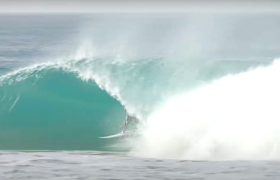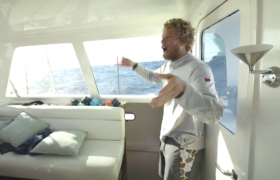“What makes a women’s surfboard?” It’s pink, probably.
A week or so ago, before the rain and the floods, I drove the 405 to San Clemente to learn about the newly launched XO Coco surfboard line. I listened to Hole on repeat, because Siri refused to change the music.
Obviously, Siri hates me.
Driving the 405 with Courtney Love screaming at me did not spark joy. I want to be the girl with the most cake.
The surfboards. You want to know about the surfboards. A collaboration between Matt Parker of Album and Hawaiian ripper Coco Ho, XO Coco is designed specifically women. Six boards comprise the line, and they range from a fish called the Tryst to the Serendipity, a singlefin longboard. Currently, they’re available in stock sizes (no customs, for now).
When I messaged a few of my friends about this story, each one asked me the same question.
“What makes a women’s surfboard?”
It’s pink, probably. While a girl can certainly buy a pink surfboard from XO Coco, there’s more to the story than cute colors.
XO Coco originated a few years ago when Coco appeared in Stab’s E.A.S.T. video series. At the time, I had a text exchange with Matt, where I learned that he had spent considerable time thinking about how to make surfboards work better for women. Intrigued, I stuffed this information in my brain for future use. There it sat, until I heard about XO Coco.
View this post on Instagram
How I learned to hate teal
Before I go any further, I should tell you that I’m a veteran of the wars over women’s product in the outdoor industry. Let’s just say, it hasn’t always been pretty.
I’ve seen screaming matches over the presence — or absence! — of pink in a product line. I’ve acquired a deep hatred for teal, though to be fair, teal has never done anything to deserve it. I have also gained a deep sympathy for anyone trying to design product for women. It turns out that we are very hard to please.
In my experience, women’s product lines go off the rails in a few ways.
One is the obvious one: The product is a poorly designed, shrunken version of a men’s product that’s painted pink. Well, if it’s pink, it must be for women! A bunch of girls? Nah, they won’t actually know if the product is actually good.
Spoiler! We know. We absolutely know.
Fortunately these days, it’s rare to see a brand fall into this very obvious trap.
More often with the best of intentions, women’s product designers define their audience too narrowly. They emphasize specially designed features for small, light humans, never mind the reality that women come in a wide range of sizes. Women aren’t necessarily small men.
There’s also a tendency to be prescriptive and argue that women can’t possibly do anynthing without a woman’s product. If we don’t like the specific teal or pink thing on offer, well, we’re definitely doing it wrong. In fact, it’s more likely that the product is poorly designed or doesn’t serve the audience it aims to reach.
All of which is to say, I’ve seen plenty of misfires, which led me to approach this notion of a women’s surfboard gingerly and with a certain degree of skepticism.
In my own life, I have ridden both stock and custom boards, and my current everyday shortboard is a stock board from CI. I’m 5’9”, so I don’t fit the assumption that women are small. Oops. My bad. In fact, I’m unnervingly close to a medium-sized man when it comes to surfboards and outdoor gear. Again, my bad.
Matt Parker is staring at your feet.
When I sit down to talk to Matt in his office at Album, it’s clear that he’s aware of many of these pitfalls.
“Not every woman is 5’2”,” he said. “There’s variety. It’s not like, every women’s surfboard is going to be some shrunk-down, tiny little thing.”
His interest in designing boards for women emerged from watching contest surfing and seeing girls surf in the lineup.
“I would be watching women surf, and the whole frame of reference is from a guy’s perspective,” he said. “So, they’re riding guys’ boards, and there’s times when it just looks off. It’s like, there’s something not right here.”
One element that immediately stood out to Matt is foot size. He wears a size 12 or 13 men’s shoe, and the average women’s size is closer to a men’s four or six. Matt believes that this difference in foot-size changes most women’s leverage on a surfboard in significant ways.
“Give Ethan Ewing a board that’s 23 1/2 inches wide, and see if he can do the same turn,” asserts Matt. When he watches women surf, he feels like their boards are working against them.
It would be nice if simply cutting a board with a narrower outline would solve all our problems. I have tried this tactic, in fact. I have a beautiful custom roundpin thruster, with lovely thin rails, and a narrow outline. It works amazing in good waves and goes rail-to-rail with glorious ease, but it sinks like a rock on an average day. I live in California. There just aren’t that many good days.
As he watched women surf, Matt kept turning over the various design elements in his mind.
“I felt like there was such a missing link in this,” he said. “I’ve thought about it forever.”
Matt imagined that a narrower outline would be more responsive under smaller feet. But that didn’t complete the puzzle. He also pictured shifting the volume so the board would continue to paddle easily and hold speed through turns.
With plenty of work to do at Album, Matt never had time to experiment. It’s a pattern that has repeated across the industry. With the razor thin margins in surfboard manufacturing, there’s little space to make a board that might sit sad and unsold on the racks. Many shapers work from their own experiences, which means shaping boards for people who look like them and surf like them. Which is to say, like men.
“If you walk into any surfboard factory, it’s a lot of the same characters, a lot of the same mindset,” Matt said. “There’s all these amazing craftspeople who know how to make amazing boards, but we can’t help but view things through our perspective.”
Coco Ho rides a twinfin — and likes it
When Coco showed up to film for E.A.S.T., she had never ridden a twinfin. She’d spent 11 years on the CT and had always ridden her contest boards.
“There’s just no time in our schedule to play around,” she told me over the phone. “It’s so full-on.” With good waves readily available to her at home in Hawai’i, Coco had less reason to experiment with small wave boards than Californians do. (Hi, it’s me, I’m the Californian.)
After years ripping on a thruster, Coco didn’t anticipate that she’d thrive on a twinfin. So, it came as a surprise to her that she liked the 5’2” twinfin that Matt made for E.A.S.T. “The drive, the speed, and the feeling of freedom through the turns” are what stood out to her. “I just expected to slide around on it, and that wasn’t the case at all.”
After Coco picked his board as her favorite out of the E.A.S.T. collection, Matt began sending her prototypes.
For years, girls in the lineup had asked Coco where to buy boards. Sometimes, she could tell them to pick up one of her used boards from Lost, her board sponsor at the time.
“I always felt bad if the person asking me wasn’t near my size,” she said. “I didn’t know where to send them.”
She also understood that many women didn’t feel confident ordering customs. “It’s not like, that inviting of a world. It’s not easy.”
So, the idea of making boards more readily available to women appealed to her.
As she worked with Matt on designs, Coco also saw the potential in starting a brand of her own. “The boys are doing it with Former and Florence Marine,” she said. “I think there’s a lot of space for all the really successful girls of my generation to do this.”
Coco mentioned that Steph has a board project on the way, too.
With Coco out testing prototypes and Matt in the shaping bay, they worked together to refine the design elements that the boards in the XO Coco collection share. The XO Coco boards each have finely tuned rails and narrow outlines. Matt played with foiling and foam placement, too, to ensure there’s enough volume and he tinkered with fin templates and positioning.
“That’s a huge part of the design, having that foam in the middle and the fuller deck,” said Coco. “That’s for speed and paddling. The foiled rails and narrower decks is for being able to release and be sharp on turns. And, there’s some magic with fin placement — but that’s our special sauce.”
For the joy of surfing
Of course, XO Coco is not the only surfboard option for women. Custom shapers such as Ashley Lloyd and Rachel Lord have gained a loyal following for their longboards. Christine Brailsford Caro shapes custom midlength and fish designs at Furrow and counts numerous women among her customers, too.
In Australia, Jaleesa Vincent is working with an anonymous shaper on a board brand, while Salt Gypsy has a collection made by GSI.
It’s also true that Matt’s design mix is not the only way to make a board that works well for a woman surfer. One of my favorite boards, for example, has a fairly wide outline. Initially, I wasn’t at all sure it would go well, but it turned out that the interaction between the rails and bottom contours made the board responsive and quick. There’s always going to be more than one way to make a magic board.
But it’s fair to say, that XO Coco is the first brand with a range of stock boards designed for women. They’re accessible and ready to ride. A girl can walk into the shop in San Clemente, plunk down her cash, and walk out with a new board. And I think that’s pretty great.
The line includes a fish, a performance twinfin, a thruster, a midlength twin, a channel-bottom singlefin, and a longboard, so there’s options to suit many surfers’ styles. The size range should also fit a good proportion of women in the lineup. Looking at the dims, I could likely find a board to ride in each design except the Aurora thruster, which tops out at 5’8″ x 17.75″ x 2.25” (24.6 liters).
While the boards at XO Coco may not work for everyone, I like the invitation to experiment they offer.
I hope that this project — and hopefully there will be others like it — help women become more saavy about their boards. One custom shaper I talked to, for example, said the main request from women customers is that they want to be able to carry the board under their arm.
I’d like to see more women know how to find boards that will feel good on the wave, not just walking down the beach. I’d love to imagine more women finding a magic board, whether its a stock board from XO Coco or another brand or it comes from the hands of a custom shaper. Surfing should be fun. I’m pretty sure that’s why we do it.
Bringing that fun to more women is a big part of what Coco hopes her brand will achieve.
“I think the most rewarding part is getting to see my friends ride the boards and be stoked and have their eyes kind of light up,” she said. “Being able to give, instead of take is really nice. And I just want to spread the love and spread the joy of surfing.”
I definitely can’t argue with that.






